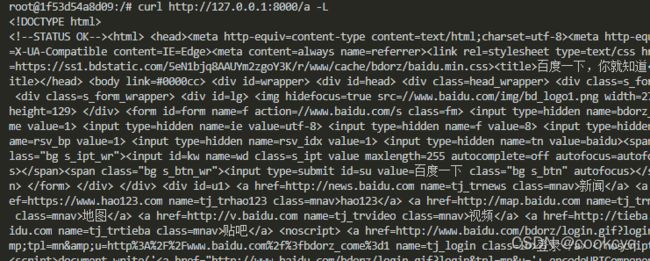Nginx & 详细举例 location -> index、return、rewrite、try_files、alias 各个属性的含义和注意事项
1、准备工作
1.1 本案例以 centos7 系统作为演示,配置文件在 /etc/nginx/conf.d/test.conf 中,内容如下
server {
listen 8000;
server_name 127.0.0.1;
root /home/cookcyq/web/;
error_page 404 /40x.html;
error_page 500 502 503 504 /50x.html;
location / {
return 200 'Hello,world';
}
}
请务必记住好这几个配置,后面的案例都是以上面作为铺垫。
1.2 /home/cookcyq/web/ 目录如下:
home
cookcyq
web
40x.html 内容为:40xxxxxxxx.html
50x.html 内容为:50xxxxxxxx.html
index.html 内容为: indexxxxxx.html
1.3 在 /etc/nginx/nginx.conf 配置文件中将上面的文件引入进来(下面这段下载时就自动加上的,如果没有看到手动加即可)
http{
...
include /etc/nginx/conf.d/*.conf;
}
1.4 重启 nginx ,访问 http://127.0.0.1/:8000/ 即可看到输出 Hello,world

接下来正式进入本文
2、location -> return
2.1 返回状态码 + 字符串
location /a {
return 200 'Hi, I am a.';
}
重启 nginx,访问 http://127.0.0.1:8000/a 输出:

2.2 重定向
location /a {
return https://www.baidu.com;
}
重启 nginx,访问 http://127.0.0.1:8000/a 重定向到 https://www.baidu.com

3、location -> index
3.1 准备工作
在 /home/cookcyq/web/ 目录下新建 a 目录,并创建 index.html 和 test.html,结构如下
home
cookcyq
web
a
index.html 内容为: Hello, index.html.
test.html 内容为:Hello,test.html.
3.2 使用
root /home/cookcyq/web/;
....
location /a {
index index.html;
}
现在访问 http://127.0.0.1:8000/a 时就会访问 /home/cookcyq/web/a/ 下的 index.html 文件

index 的作用就是当没有访问任何文件时,则默认访问 index.html
现在我们来指定一个,如 http://127.0.0.1:8000/a/test.html 就会访问 /home/cookcyq/web/a/ 下的 test.html 文件

如果我们指定一个不存在的文件比如 http://127.0.0.1:8000/a/ffff.html 则存在两种情况:
- 如果存在 , location / {} 则先访问
location / {
return "Hello,wolrd"
}
4、location -> try_files
try_files 的细节蛮多的,稍不小心就掉进坑里,大家可要细心点哦。
4.1 准备工作
在 /home/cookcyq/web/ 目录下新建 b 目录结构如下
home
cookcyq
web
b
foo.html 内容为: Hello, foo.html.
bar.html 内容为:Hello,bar.html.
index.html 内容为:Hello,b1, index.html.
b2
bird.html 内容为:Hello,Bird.html
index.html 内容为:Hello,b2, index.html
请务必记住好这些结构,下面将会使用以上结构作为示例。
4.2 使用
location /b {
try_files $uri $uri/ /b/index.html;
}
参数解释:
- 参数一 $uri 表示访问 /b/path/anyfile
- 参数二 $uri/ 表示访问 /b/path/ 时,访问该目录下的 index.xxx 索引文件
注意:如果该目录下不存在任何 index.xxx 索引文件则返回 403,如果访问不存在的目录则返回 500。 - 参数三 表示如果前面两个都找不到则访问 /b/index.html
注意:如果 /b/index.html 也不存在,则返回 500
接下来我会一一演示如何触发这三个参数:
4.2.1 访问 http://127.0.0.1:8000/b/foo.html 则对应 $uri
4.2.2 访问 http://127.0.0.1:8000/b/b2/bird.html 则对应 $uri

4.2.3 访问 http://127.0.0.1:8000/b/ 则对应 $uri/
4.2.4 访问 http://127.0.0.1:8000/b/b2/ 则对应 $uri/

4.2.5 访问 http://127.0.0.1:8000/b/oooo.html 由于 oooo.html 不存在,则对应第三个参数 /b/index.html。
4.2.6 访问 http://127.0.0.1:8000/b/b2/oooo.html 由于 oooo.html 不存在,则对应第三个参数 /b/index.html。

4.2.7 访问 http://127.0.0.1:8000/b/oooo.html 或 http://127.0.0.1:8000/b/b2/oooo.html 由于 oooo.html 不存在,且第三个参数 /b/index.html 也不存在的话(手动把index.html删掉或重命名即可实现效果),则返回 500

4.3 注意事项
- 第三个参数推荐使用绝对路径的形式
/path/index.html,请不要采用$uri/index.html,因为$uri/是动态的目录,会随着 url 发生变化而变,这样很容易产生找不到目录而报 500 的问题 - 第三个参数的
/代表 root 根目录,但它并不会累加 location /b {} ,比如第三个参数为/index.html它对应的是root/index.html而不是root/b/index.html,这就是为什么上面的第三个参数为/b/index.html,而如果是 location /b { index /index.html } 则会累加root/b/index.html的形式,这点要注意。
5、location -> rewrite
rewrite 的细节也挺多的,不过理解起来很容易。
5.1 准备工作
在 /home/cookcyq/web/ 目录下新建 c 目录结构如下
home
cookcyq
web
c
c.html 内容为:Hello, c.html.
r
1.html 内容为:Hello, 1.html.
2.html 内容为:Hello, 2.html.
3.html 内容为:Hello, 3.html.
请务必记住好这些结构,下面将会使用以上结构作为示例。
5.2 使用
语法:rewrite [匹配模式] [重定向目标] [指令(可选)]
5.2.1 简单使用
location /c {
rewrite ^(.*)$ /r/1.html;
}
当访问
http://127.0.0.1:8000/c
http://127.0.0.1:8000/c/c.html
http://127.0.0.1:8000/c/xxx/xxx/xxx
都会重定向访问 root/r/1.html

记得把前面 location / { return 200 ‘Hello,world’ } 语句去掉,因为 return 指令会跳过下面的 location
5.2.2 带有 last 指令
location /c {
rewrite ^(.*)$ /r/1.html last;
# 不会触发这个,因为 last 会跳过下面的执行语句
rewrite ^(.*)$ /r/2.html last;
}
当访问
http://127.0.0.1:8000/c
http://127.0.0.1:8000/c/c.html
http://127.0.0.1:8000/c/xxx/xxx/xxx
都会重定向访问 root/r/1.html

5.2.3 带有 last 指令
location /c {
rewrite ^(.*)$ /r/1.html last;
# 不会触发这个,因为 last 会跳过下面的执行语句,但它会继续走进下一个 location 块
rewrite ^(.*)$ /r/2.html last;
}
# 这里监听 /r/1.html 再做一次重定向
location = /r/1.html {
rewrite ^(.*)$ /r/3.html last;
}
当访问
http://127.0.0.1:8000/c
http://127.0.0.1:8000/c/c.html
http://127.0.0.1:8000/c/xxx/xxx/xxx
都将重定向访问 root/r/3.html

5.2.4 带有 break 指令
location /c {
rewrite ^(.*)$ /r/1.html break;
# 不会触发这个,因为 break 会跳过下面的执行语句
rewrite ^(.*)$ /r/2.html last;
}
http://127.0.0.1:8000/c
http://127.0.0.1:8000/c/c.html
http://127.0.0.1:8000/c/xxx/xxx/xxx
都会重定向访问 root/r/1.html

5.2.5 带有 break 指令
location /c {
rewrite ^(.*)$ /r/1.html break;
# 不会触发这个,因为 break 会跳过下面的执行语句,同时也会跳过下面的 location 块
rewrite ^(.*)$ /r/2.html last;
}
# 由于 break 这里不会触发到
location = /r/1.html {
rewrite ^(.*)$ /r/3.html last;
}
http://127.0.0.1:8000/c
http://127.0.0.1:8000/c/c.html
http://127.0.0.1:8000/c/xxx/xxx/xxx
都会重定向访问 root/r/1.html

5.2.6 容易犯错的重定向案例
location /c {
rewrite ^(.*)$ /r/1.html last;
}
location = /r/1.html {
index /r/2.html;
}
思考一下,最终会重定向到哪里?
其实如果你知道 index 的作用,答案就简单多了,这里只会重定向到 root/r/1.html 而不会访问 root/r/2.html,因为 index 只是未访问任何文件时作为默认访问索引文件的指令。

5.3 注意事项
- rewrite 重定向目标如果不存在则走进 error_page 404 /40x.html
- 如果 root 是 /home/cookcyq/web 没有加
/,那么重定向目标时得加/,反之 root 有加/则重定向目标可加可不加/
6、location -> root 与 alias
假如我们不想让每个 location 都继承 root,而是拥有自己的 root,那么 location 内的 root 与 alias 指令就是很好的选择。
6.1 准备工作
目录结构
home
cookcyq
web
d
1.html 内容为 Hello, 1.html
index.html 内容为 Hello, web index.html
my
d
foo.html 内容为 Hello, foo.html.
index.html 内容为 Hello, my index.html.
6.2 root
root /home/cookcyq/web/;
location /d {
root /home/cookcyq/my/;
try_files $uri $uri/ /d/index.html;
}
当我们访问 http://127.0.0.1:8000/d/foo.html 就会访问 /home/cookcyq/my/d/foo.html

6.3 alias
root /home/cookcyq/web/;
location /d {
alias /home/cookcyq/my/d/;
try_files $uri $uri/ /d/index.html;
}
当我们访问 http://127.0.0.1:8000/d/foo.html 就会访问 /home/cookcyq/my/d/foo.html

6.4 root 与 alias 的区别
root 指令最终形成的路径为:root+location xxx/*
alias 指令最终形成的路径为:alias/*
